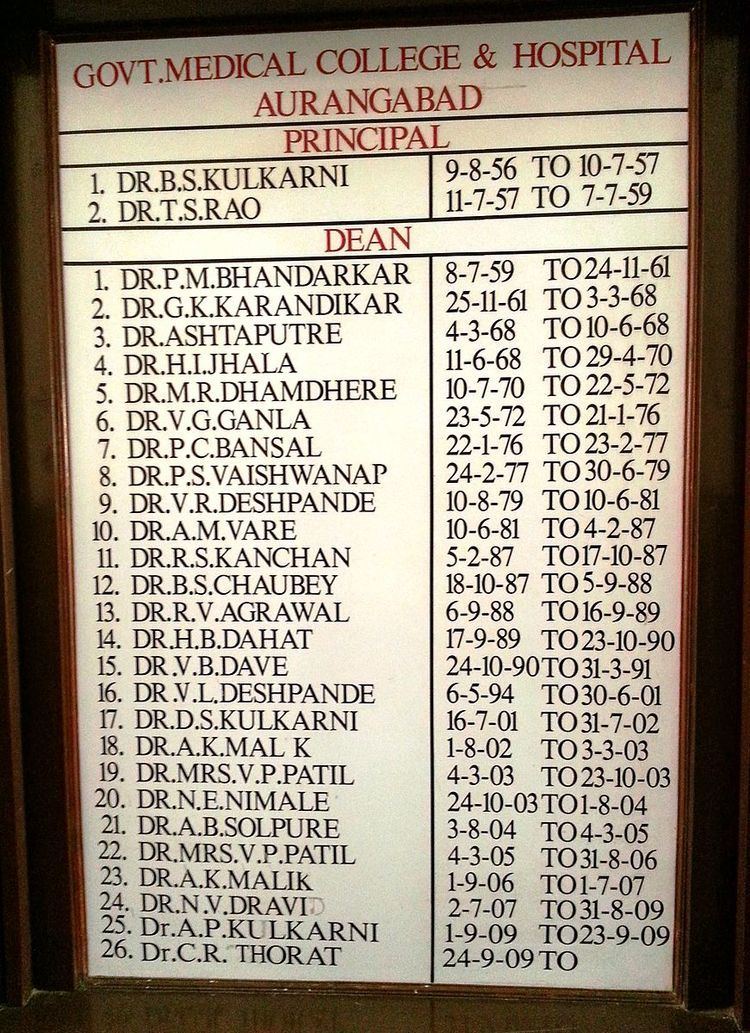Established 1956 Dean Dr Chandrakant Mhaske Postgraduates 81 per year Founded 1956 | Endowment Government Funded Undergraduates 150 per year Phone 0240 240 2028 Motto Selfless service | |
 | ||
Type Education and research institution Address Panchakki Road, Aurangabad, Maharashtra 431001 Similar Government Medical College, Shri Bhausaheb Hire Gov, Government Medical College, Dr V M Government Medical, ACPM Medical College | ||
The Government Medical College (GMC) & Hospital (GMCH), Aurangabad (Marathi: शासकीय वैद्यकीय महाविद्यालय व रुग्णालय, औरंगाबाद) is a medical school affiliated to the Maharashtra University of Health Sciences (MUHS), Nashik. The College is recognized by the Medical Council of India (MCI), New Delhi for medical education in India. Founded in 1956 it is one of the premier medical institutions in the state of Maharashtra. At present, the college accepts 150 students per year for the undergraduate course MBBS and around 85 students per year for the various postgraduate courses. The college has an excellent training centre for young medical aspirants like doctors, nurses and Bachelor of Para medical Technology (BPMT) students in the science of medicine.
Contents
Location
The college is located on the east bank of Kham river in northwest part of Aurangabad city, very close to famous tourist attractions like Panchakki, Bibi Ka Maqbara and Dr. Babasaheb Ambedkar Marathwada University. The college is 4 km away from the Aurangabad Railway Station,1.5 km away from the central bus stand and 11 km away from the Chikkalthana Airport.
History
The college was established on 15 August 1956, on the occasion of the 10th independence day of India. The college was started with 50 undergraduate students in a small Nizam Bungalow in the cantonment area of the city while infectious, obstetrics & ophthalmology wards were located at Amkhas in the other part of the city. The foundation stone for the present main building of the medical college was laid down by then chief minister of Bombay State, Yashwantrao Chavan, in presence of Swami Ramanand Teerth, on 27 October 1957. The building was inaugurated by Sushila Nayyar, then Minister of Health, Government of India, on 20 June 1964. Various other buildings were added to the campus over a period of time. For initial few batches, after completing the first year in the college students had to go to Government Medical College, Nagpur, to complete their second and final year of MBBS curriculum. From its inception till 1963, the college was affiliated to Osmania University, Hyderabad. After 1963, it was affiliated to the newly formed Marathwada University (now Dr. Babasaheb Ambedkar Marathwada University) located at Aurangabad. And since 1998, the college is affiliated to MUHS, Nashik, a centralized health university for health education in the state of Maharashtra.
The admission strength of college was subsequently increased to 100 undergraduate students per year and now it is allowed to take 150 MBBS students per year. Similarly, post graduation seats were added to various departments of the college; the current intake capacity is 85 post graduate students per year. The college & hospital complex now consists agglomeration of 30 buildings spread over 99 acres. The hospital of the college started with 300 beds in a small Nizam Bungalow in 1960 is now equipped with 1170 beds distributed across various departments and wards.
The college has been providing medicinal services to the people of Marathwada region and surrounding districts of Vidarbha and Khandesh regions round the clock for the last 55 years.
Academics
The courses offered by the institute are:
The graduates from the institute are highly placed & are catering medical services in various fields in India & abroad.
Undergraduate courses
The GMC, Aurangabad accepts 150 students every year for MBBS course. The admission is based on merit in the MHT-CET. But for academic year 2013-2014, it was based on merit in the National Eligibility cum Entrance Test.
The college has 120 BPMT student intake. The BPMT course is for the posts of lab technician, radiology technician, radiotherapy technician, community and medicine technician etc.
Post-graduate courses
The post-graduate students in various courses of medicine and surgery get admitted to GMC through all India and Maharashtra state level post-graduate medical entrance examinations.
Medical services
The special facilities available at GMCH, Aurangabad include Intensive Care Unit (ICU), Intensive Coronary Care Unit (ICCU), Medicine Intensive Care Unit (MICU), Neonatal Intensive Care Unit (NICU), Paediatric Intensive Care Unit (PICU), CT scan, MRI and a blood bank amongst other facilities. It is backed up by Central & Departmental Laboratories for all the investigations round the clock.
To provide a quality healthcare for people in rural area, the Preventive and Social Medicine (PSM) department of GMC operates one rural health and training centre at Paithan 50 km from Aurangabad. The PSM department also operates one urban healthcare centre in the Shahganj area of Aurangabad.
Speciality care centres at GMCH
The super-speciality care centres at GMCH include
Research at GMCH
Both non-clinical and clinical departments of the GMCH are involved in active research in number of fields. Faculty and students of the GMCH have their research papers published in number of national and international journals.
Sandfly fever, an aroboviral disease is known to occur in the arid regions of West Pakistan and Middle East. Its occurrence in India was thought to be doubtful. However, in 1967, the sandfly fever virus was isolated in Aurangabad from febrile cases.
Residential facilities
The GMC provides residential facility for all its faculty members, staff and students inside the campus. There are two hostels for male undergraduate students (Old and New Boys Hostel), a single hostel for female undergraduate students and a separate hostel for Nursing students. Post-graduate students have a separate residential block. The quarters for nursing and other staff are also located inside the campus.
